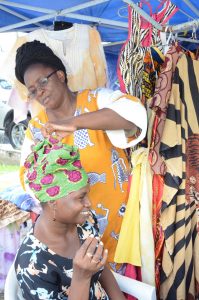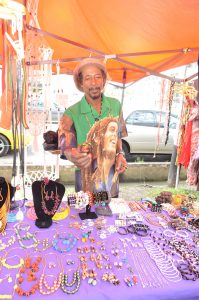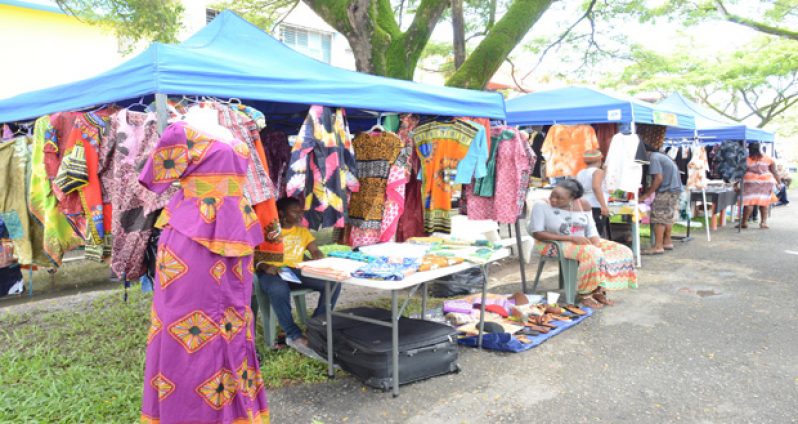THE 176th Emancipation commemmoration in Guyana will take place tomorrow, and to mark the occasion, an exhibition and sale is now on in the avenue along Main Street, Georgetown, where booths were set up showcasing various African clothing and jewellery, among other things.There were about 10 booths since the exhibition and sale started on Monday, and one of the exhibitors/vendors Patricia Helwig, who is also a designer/caterer, did African-style head-wraps for customers.

Helwig has on display a wide variety of tailored African prints, which she made herself, but noted that sales this year unlike others are a bit slow due to bad weather; but people were still coming out to give support and a few sales were effected.
She told this newspaper that her dashiki and other African clothing are very reasonably priced, and she does her own thing as it relates to styling of her clothes for sale.
A head-wrap costs $2000 and she encouraged Guyanese to take advantage of her services since the exhibition and sale ends today.
Another vendor, Junior Vancooten, who had on display a wide variety of hand-crafted jewellery, from chains to earrings and bands, among other pieces, said the event was well received, and given his 17 years in the making of fashion and culture jewellery, his pieces are genuine and of excellent quality.
EMANCIPATION
The inhumane system of slavery was abolished on August 1, 1834 in all British colonies, including British Guiana, now Guyana.
While the British Emancipation Act was passed in 1833, it came into force in 1834. The Emancipation Act catered for a period of transition called the apprenticeship system under which the ex-slaves were still subjected to their former masters. This apprenticeship system lasted for another four years, 1834-1838, after which “full freedom” was achieved, bringing to an end the atrocious system of slavery which for centuries had brought so much pain, suffering, and bitterness.
But Emancipation also meant the triumph of the African spirit and the significance of its anniversary takes on a distinctly African identity. It is an occasion for recalling the significance of all the factors mentioned above, but the people take the opportunity to highlight whatever they can of African cultural vestiges. Several of the African cultural survivals have weakened considerably, disappeared, or are no longer practised in their original forms, but others are still alive in communities or in normal Guyanese life, and these are colourfully revived or exhibited on the first of August.
ACTIVITIES
There are many public and highly visible exhibitions which mark the celebrations from the end of July.

The activities in this festival include demonstrations of folk and village games; the exhibition and sale of craftwork, using African motifs and styles; craftwork and artifacts made out of indigenous materials; artwork, drawings and paintings; food with an emphasis on “African” cuisine; “local” and “creole” food items and drinks; booths displaying posters, photographs, books and other printed materials providing information on history and African affairs.
Other events which attempt to recapture past customs include the “Vigils” and “Libation ceremonies” on the night before Emancipation Day. This is usually a very busy night for activities.
An important highlight of the Vigil is the Libation Ceremony, which is performed at midnight as a rite of passage into August 1. It is also a surviving or revived African ritual of ceremonial offerings, tributes and prayers to the spirits of the ancestors. The details of the ceremony vary from place to place, but it is essentially the pouring of libation, often alcoholic spirits -white rum, but different symbolic liquids may be used by different people- as an offering to the deities for their blessing, protection and guidance, or as thanksgiving for safe passage in the affairs of men. The kind of spirits used is significant because the ritual seeks to invoke the spirits or otherwise communicate with them. It is an old African ritual belonging to the principles of ancestor worship.
SOIRÉE GALORE
There is also the traditional holding of “soirées.” This derives from the French word, soir/soirée, and describes an evening or an evening of entertainment or a fete. Although Guyana is not historically a Francophone country, a few French terms exist in common use, and “soirée” is one of them, but there has been no known investigation into how it came to be used. Two Guyanese villages in West Berbice are known for the soirée tradition: Hope Town and Lichfield. Here there is a grand street party with drumming, recorded music, sometimes some other performances and recorded music. Festivities proceed through the night, ending at no specific time in the wee hours of the morning. There is much dancing and drinking.
These are the main public activities through which Guyana commemorates the anniversary of Emancipation each year. Although Emancipation is of defined universal significance and is of interest to the entire nation of Guyana, it is an occasion for the celebration of the country’s African heritage and includes a fair amount of traditions, exhibits and performances.
By Michel Outridge




.png)









